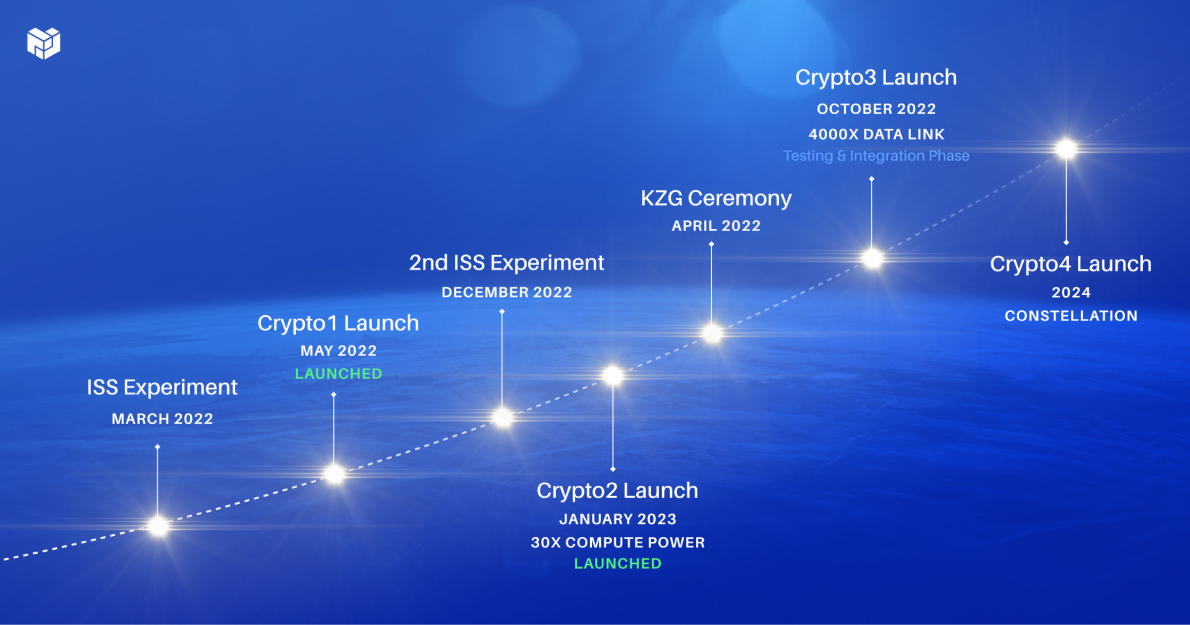Snapshot: Cryptosat builds small, cost-efficient satellites that provide the cryptographic trust infrastructure for Web3 via perfect physical isolation in space.
The impact: By launching mini-satellites into space and building effective communications mechanisms, Cryptosat has solved one of the biggest challenges facing the evolving Web3 and blockchain ecosystem: attaining the highest level of privacy and trust. There is no physical access to the satellites post-launch, preventing sophisticated side-channel attacks, and the software running on the satellite generates digital signatures in space that allow for quick, secure verifiability.
On joining PLN: Protocol Labs first partnered with Cryptosat at the end of 2021 (opens new window) to support a group of Stanford University PhDs and alumni specializing in satellite technology and cryptography for blockchain.
What’s on the radar: Cryptosat has successfully launched two cryptographically equipped satellites, Crypto1 (opens new window) and Crypto2 (opens new window), with plans for a third later this year.

# How it started: A moon mission, a collaboration and a problem to solve
Co-founders Yan Michalevsky (opens new window) and Yonatan Winetraub (opens new window) met as students at Stanford University with mutual dreams of space exploration. Winetraub, an aerospace engineer by trade, was known for starting SpaceIL (opens new window), a $100 million nonprofit focused on space education, which led to the first private spacecraft on the moon (opens new window). Michalevsky did his PhD in security and cryptography.
They co-authored a technical paper (opens new window) about cryptography, satellites and tamper-proof data computation, focused on the idea of isolating satellites in space. Amid the rise of Web3, the launch of Cryptosat served as a practical application: performing cryptographic protocols in a private and safe environment.
“While studying security systems for protecting computation, the seed was planted for us to find an ultimate solution,” said Michalevsky. “Then we had the idea to isolate things in space and we began to monitor the fast adoption of satellites.”
# Evolutions in crypto and aerospace engineering made tech possible
Cryptosat kicked off with the launch of Crypto1 (opens new window) in May 2022, sharing a ride aboard a Falcon 9 rocket for a SpaceX mission. The size of a cereal bowl, Crypto1 was made from off-the-shelf satellite parts as a tamper-proof means to perform data compute, secure blockchains and other Web3 protocols.
In addition to the natural privacy that comes with physical isolation in space, the software running on the satellite, as well as the responses coming from it, is attested by a digital signature generated by the satellite, using a private key that is generated in space. The corresponding public key is broadcast at the beginning of the satellite's service lifetime, such that multiple independent parties can receive the transmission and agree that they see the same public key coming from the satellite.
Crypto2 (opens new window) was then successfully launched less than a year later in January 2023, and there are plans for a third satellite deployment by the end of the year. Utilizing Bacalhau (opens new window), the aim is to build a constellation of satellites for Web3, cryptographic protocols and confidential computing.
“In aerospace, if you build a satellite within five years, it's standard. We did it in roughly six months. We were all about moving fast and trying to get to production as quickly as possible – lightspeed by aerospace standards,” said Winetraub. “With the crypto component, the idea was to increase our compute capabilities to something that more modern processors can do, so we plan to launch Crypto3 later this year.”

# The Future: Decentralized cloud computing and the launch of Crypto3
Cryptosat is exploring a host of potential use cases for its innovations, including collaborations with wallet companies and further exploration into decentralized cloud computing. The company plans to collaborate with Protocol Labs to run an IPFS node aboard one of Cryptosat’s satellites.
The team’s longer term objective is to launch a constellation of satellites, aiming for “a few dozen” that can provide continuous service to the blockchain community. This stems from a belief that the next five to 10 years will see all major blockchains shifting to use space-based infrastructure to some extent.
Running parts of the blockchain in space offers advantages in speed, transparency, cost and energy usage. And there are many services that are able to run faster and more securely with only a few nodes in space, compared to thousands of nodes on Earth.
The concept is gaining traction, with Blockstream transmitting Bitcoin (opens new window) from space, the Filecoin Foundation collaborating with Lockheed Martin (opens new window) to run IPFS on satellites, and Cryptosat participating in the Ethereum KZG ceremony (opens new window) in space.
“The next natural step is to be constantly available. We don't want anybody to wait more than a couple of seconds before they can get their answers,” said Winetraub. “That's going to be the future.”
Connect with the Cryptosat team at info@cryptosat.io, on Discord (opens new window) or on their website (opens new window).
# Further Reading
Compute on Data in Space (opens new window)
Cryptosat and Protocol Labs Collaborate to Take Cryptography to Space (opens new window)
Cryptosat launches second ‘cryptographically-equipped’ satellite using SpaceX rocket (opens new window)
A Crashed Israeli Lunar Lander Spilled Tardigrades on the Moon (opens new window)
